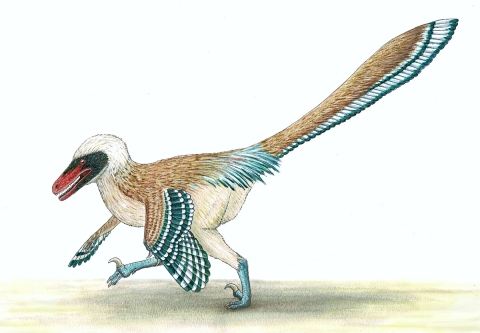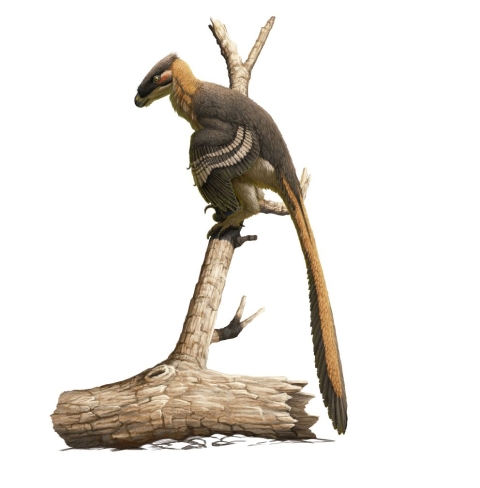

This is the first time a large raptor has been found in the UK.
21 December 2021
5 min read
A new bird-like dinosaur that used brute strength to overcome its prey has been found by palaeontologists combing through fossils found on the Isle of Wight.
The new animal has been named Vectiraptor greeni after local collector Mick Green who discovered its bones after they became washed from the rocks on the island’s south coast. It was an older, more heavily built, relative of the predator Velociraptor. The fearsome animal was about the size of a wolf, about 3 metres (10 feet) long, from nose to tail, and would have used huge slashing talons on its feet to dispatch its prey. Its finely serrated teeth were then used to bite off pieces of the kill.
The dinosaur would have prowled through the forests that covered the land in the Early Cretaceous, 125 million years ago. It died and lay buried until 2004, when storms and waves eroded away the rocks that had kept its bones hidden. Yet another 20 years passed before scientists from the Universities of Bath and Portsmouth studied the fossils and made the surprising find that the bones represented a new species. Their discovery is described this week in the journal Cretaceous Research.
Vectiraptor belonged to a group of dinosaurs called dromaeosaurs, or raptors. These bird-like dinosaurs were specialist hunters and, like their modern-day avian relatives, were covered in long feathers. Their jaws were full of blade-like, serrated teeth and they had huge scythe-shaped claws on their feet, used to slash at their prey, causing it to rapidly bleed to death.

Vectiraptor greeni, a new fierce predatory dinosaur from the Isle of Wight. Image credit: Megan Jacobs
Well-known members of the raptors include Velociraptor from Mongolia, and Deinonychus, and the giant Utahraptor from the United States. A smaller raptor has previously been described from the Isle of Wight but Vectiraptor marks the first time a large raptor has been found in England. Although only fragments of the skeleton have survived– a pair of vertebrae from the back, and part of the hips – what is known suggests a large, powerfully built animal.
“This was a large, and very heavily constructed animal,” said Dr Nick Longrich, who led the study from the Milner Centre for Evolution at the University of Bath. “The bones are thick-walled and massive. It clearly didn’t hunt small prey, but animals as large or larger than itself.”
Although not the biggest predator in its environment – top predators included the allosaur Neovenator, spinosaurs like Baryonyx, and an early tyrannosaur called Eotyrannus – Vectiraptor would have been a threat both to smaller dinosaurs and juveniles of large dinosaurs. With strong arms and talons, it may have climbed trees like modern leopards. The heavy bones suggest an animal that relied less on speed and more on strength, and perhaps ambushes, to tackle its prey.
“It’s a tantalising hint at the diversity of dinosaurs in England at this time,” said Dr Longrich.
This is the first time a large raptor has been found in the UK. “There’s an extraordinary diversity of dinosaurs known in England in the Cretaceous, and even after more than a century of study, we continue to find new species,” said Dr Longrich. “Although palaeontologists have been studying these dinosaurs for a long time, it’s hard going. We have to wait for the sea cliffs to fall and expose bits of bone, or for the waves to wash them out of the rocks. We’ve spent two centuries on the Isle of Wight piecing together our picture of English dinosaurs.”
This little dinosaur also serves as an excellent example of the importance of amateur fossil collectors, and how working with them can produce important scientific research, which would otherwise not be possible.
Megan Jacobs, PhD student
Co-author Professor Dave Martill of the University of Portsmouth notes that raptors closely related to Velociraptor have also been found in Mongolia, suggesting that England may have lain along an important dispersal route for dinosaurs. Professor Martill said, given the similarity between North American and Mongolian dinosaur faunas in the Early Cretaceous, it was only a matter of time before someone discovered a raptor dinosaur in England.
A remarkable number of dinosaur species originate from this small island off southern England. Ancient England was something of a crossroads for dinosaurs. At the time the continents were closer together, with some connected by land bridges. Dinosaurs likely wandered in from North America and Asia, or perhaps swam from Africa. Europe was a sort of crossroads linking the continents.
A chance encounter
Vectiraptor greeni was named after amateur paleontologist Mick Green, who discovered the remains in 2004 but didn’t appreciate the importance of his find until he was forced by ill-health to stop collecting fossils in 2012. He then turned his attention to prising the dinosaur bones free from the hard ironstone surrounding them.
One day, chatting over a beer, he showed the fossils to Isle of Wight palaeontologist Megan Jacobs and Dr Longrich who puzzled over them, and at first struggled to make sense of them, until they noticed tell-tale similarities to other raptors. Mr Green allowed the bones to be studied, and they turned out to represent a new genus and species. The bones have now been donated to the Dinosaur Isle Museum at Sandown on the Isle of Wight.
“This dinosaur is incredibly exciting, adding to the huge diversity of dinosaurs here on the Isle of Wight, and helping to build a bigger picture of the Early Cretaceous world,” said Megan Jacobs, PhD student at the University of Portsmouth and a collaborator on the project. “This little dinosaur also serves as an excellent example of the importance of amateur fossil collectors, and how working with them can produce important scientific research, which would otherwise not be possible.”
Without the dedication of Mick Green and others on the island, she noted, this dinosaur would have been lost to the sea.
The paper “A new dromaeosaurid dinosaur from the Wessex Formation (Lower Cretaceous, Barremian) of the Isle of Wight, and implications for European palaeobiogeography” is published in Cretaceous Research. Its authors are Dr Longrich, from the University of Bath and Professor Dave Martill and Ms Megan Jacobs from the University of Portsmouth.
